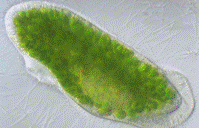Biological Sciences, School of

School of Biological Sciences: Faculty Publications
Document Type
Article
Date of this Version
2003
Citation
Nucleic Acids Research, 2003, Vol. 31, No. 2 619±628
Abstract
The finding in animal species of complexes homologous
to the products of six Saccharomyces cerevisiae
genes, origin of replication recognition
complex (ORC), has suggested that ORC-related
mechanisms have been conserved in all eukaryotes.
In plants, however, the only cloned putative homologs
of ORC subunits are the Arabidopsis ORC2 and
the rice ORC1. Homologs of other subunits of plant
origin have not been cloned and characterized. A
striking observation was the absence from the
Arabidopsis genome of an obvious candidate genehomolog
of ORC4. This fact raised compelling
questions of whether plants, in general, and
Arabidopsis, in particular, may have lost the ORC4
gene, whether ORC-homologous subunits function
within a complex in plants, whether an ORC complex
may form and function without an ORC4 subunit,
whether a functional (but not sequence)
protein homolog may have taken up the role of
ORC4 in Arabidopsis, and whether lack of ORC4 is a
plant feature, in general. Here, we report the first
cloned and molecularly characterized five genes
coding for the maize putative homologs of ORC subunits
ZmORC1, ZmORC2, ZmORC3, ZmORC4 and
ZmORC5. Their expression proiles in tissues with
different cell-dividing activities are compatible with
a role in DNA replication. Based on the potential of
ORC-homologous maize proteins to bind each other
in yeast, we propose a model for their possible
assembly within a maize ORC. The isolation and
molecular characterization of an ORC4-homologous
gene from maize argues that, in its evolution,
Arabidopsis may have lost the homologous ORC4
gene.


Comments
Copyright 2003 Oxford University Press